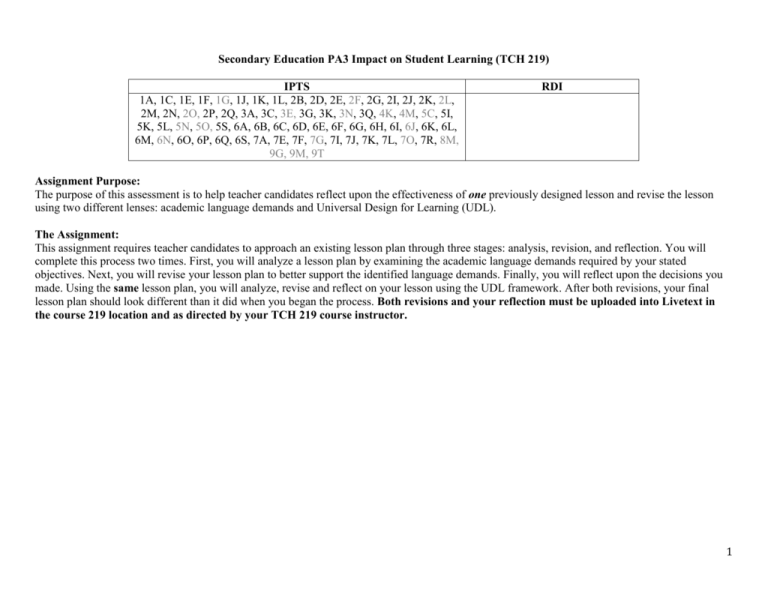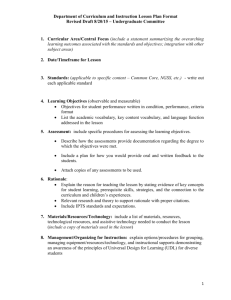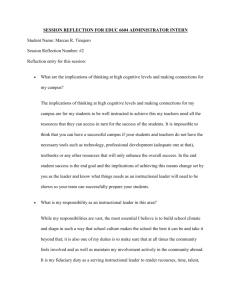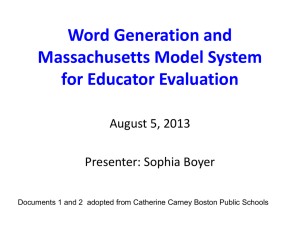Secondary Education PA3 Impact on Student Learning (TCH 219
advertisement

Secondary Education PA3 Impact on Student Learning (TCH 219) IPTS 1A, 1C, 1E, 1F, 1G, 1J, 1K, 1L, 2B, 2D, 2E, 2F, 2G, 2I, 2J, 2K, 2L, 2M, 2N, 2O, 2P, 2Q, 3A, 3C, 3E, 3G, 3K, 3N, 3Q, 4K, 4M, 5C, 5I, 5K, 5L, 5N, 5O, 5S, 6A, 6B, 6C, 6D, 6E, 6F, 6G, 6H, 6I, 6J, 6K, 6L, 6M, 6N, 6O, 6P, 6Q, 6S, 7A, 7E, 7F, 7G, 7I, 7J, 7K, 7L, 7O, 7R, 8M, 9G, 9M, 9T RDI Assignment Purpose: The purpose of this assessment is to help teacher candidates reflect upon the effectiveness of one previously designed lesson and revise the lesson using two different lenses: academic language demands and Universal Design for Learning (UDL). The Assignment: This assignment requires teacher candidates to approach an existing lesson plan through three stages: analysis, revision, and reflection. You will complete this process two times. First, you will analyze a lesson plan by examining the academic language demands required by your stated objectives. Next, you will revise your lesson plan to better support the identified language demands. Finally, you will reflect upon the decisions you made. Using the same lesson plan, you will analyze, revise and reflect on your lesson using the UDL framework. After both revisions, your final lesson plan should look different than it did when you began the process. Both revisions and your reflection must be uploaded into Livetext in the course 219 location and as directed by your TCH 219 course instructor. 1 Academic Language Demands Analysis For the entirety of this assignment, please select one lesson plan you have developed in a past course (i.e. TCH 216 or a content methods course). As you examine your objectives, identify one language function that is essential for students to meet your objective. Possible language functions include (but are not limited to): analyze, argue, categorize, compare/contrast, describe, explain, interpret, predict, question, retell, summarize. Use the following charts to help you analyze the language demands of your learning objective. Identify the learning objective and highlight the language function: Language Demand Component How will the students use this component to fulfill the language function? What instructional supports will you provide to help students successfully use this language demand? Why are you using these particular instructional supports? Specific terms (vocabulary) and/or symbols Syntax Discourse 2 How will you assess student mastery of the language demands of this objective? Language Demand Component How will you measure student achievement of this language demand? How will this assessment strategy allow you to measure student achievement of this language demand? Specific terms (vocabulary) and/or symbols Syntax Discourse Revision Once you have analyzed your lesson plan, revise the lesson to reflect the information in the charts. You may need to revise your objectives, learning strategies, texts, and/or materials. Make sure to track your changes so your instructor can compare your original lesson plan to your revised lesson plan. Reflection Reflect upon the decisions you made to guide your revisions. The focus of your reflection should be on language functions and demands. Use the following prompts to guide your reflection: 1. Describe the vocabulary, syntax, and discourse students need to understand and/or use. 2. How will the identified language function and demands (vocabulary, syntax, discourse) help your students develop their content understanding? 3. What changes did you make and why do you think these changes will improve student learning? Support your explanation with evidence of student learning and principles from theory and/or research as appropriate. 3 Universal Design for Learning (UDL) and Literacy Analysis For the entirety of this assignment, use the same lesson plan you used for the academic language analysis above. As you examine your objectives, determine how your instructional tasks and supports are designed to meet the needs of students in your class as a whole, as well as individuals. First, look at your lesson design through the lens of UDL. Then, examine what literacy strategies you use to support students throughout the four phases of learning. Use the following charts to help you analyze your lesson. Identify how your instructional tasks and supports are designed to meet the principles of UDL, supporting the needs of your students (Please label each piece of evidence by guideline and checkpoint, i.e. 2.1.) All principles should be evident throughout your lesson, but all objectives may not address all principles. Learning Objective Principle 1: Multiple Means of Representation Principle 2: Multiple Means of Action and Expression Principle 3: Multiple Means of Engagement Evidence Evidence Evidence Rationale Rationale Rationale Evidence Evidence Evidence Rationale Rationale Rationale Evidence Evidence Evidence Rationale Rationale Rationale 4 What literacy strategies will you use to support each phase of learning? Learning Phase Literacy Strategy Student Needs to Successfully Complete the Strategy/Task Rationale for Strategy Phase 1: Activating and Connecting Phase 2: Monitoring and Checking Phase 3: Consolidating and Reconnecting Phase 4: Extending and Reflecting Revision Once you have analyzed your lesson plan, revise the lesson to reflect the information in the charts. You may need to revise your objectives, learning strategies, texts, and/or materials. Make sure to track your changes so your instructor can compare your original lesson plan to your revised lesson plan. Reflection Reflect upon the decisions you made to guide your revisions. The focus of your reflection should be on how you use UDL and literacy strategies to differentiate your instruction to meet the needs of all your learners. Use the following prompts to guide your reflection: 5 1. Consider prior academic learning and prerequisite skills related to the central focus of your lesson. What do students know? What can they do? What are they learning to do? 2. Describe and justify why your instructional strategies and supports are appropriate for the whole class and students with similar or specific learning needs. (Consider students with IEPs, English language learners, struggling readers, underperforming students, those with gaps in academic knowledge, and/or gifted students.) 3. Describe how your instruction linked students’ prior academic learning and personal, cultural, and community assets with new learning. 6




